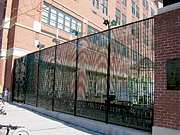
For weeks, trucks carrying smoldering, dirty wreckage from the site passed in front of the school. Both the trucks and the particles in the air from the wreckage contributed to the poor air quality at schools like PS/IS 89. This air quality also concerned the local Parent Teachers Association (PTA), which sought assurance that the school was contaminant-free and that air quality standards met expectations.
Although many New York City Schools suffered from poor air quality under extreme circumstances, they are not alone, according to John Fee, manager of business development for Blueair, Inc. "Many schools across the nation bear the same problem of poor air quality," Fee said.
"A recent General Accounting Office study estimates that more than half the nation's schools have poor IAQ. Studies show that a typical school may be two to five times more polluted than outside air. These studies show that students in most schools in the U.S. are breathing air that is full of contaminants. That air must be filtered. More and more schools are looking toward in-room air purifiers to do just that."
Resolving the IAQ Blues
To help the New York City Schools improve IAQ, Blueair donated 25 of its 625-sq-ft room capacity Model 501 air purifiers to the city board of education and sold another 75 to the board at cost. The 100 Blueair units were immediately distributed to three schools. PS/IS 89 received 58 units, Primary School 234 (PS 234) received 20 units, Intermediate School 150 (IS 15) received 15 units, and the board of education offices received seven units for use in other areas.
The Blueair product line uses patented HEPASilent(tm) filter technology that combines HEPA-type mechanical filtration and electronic precipitator technology without emitting ozone. This provides a high level of filtration at low pressure for extra air purification and less noise. The filters possess noise levels of 35db to 71db (roughly the equivalent noise made by a personal computer) making them perfect for classroom use and power consumption is 15W to 95W (about the same as a light bulb).
Clearing the air
Built four years ago in 1998, the all-brick, five-story PS/IS 89 structure has 50 classrooms, ranging in size from 200 to 600 sq ft. Barbara Kariya, an administrative assistant, coordinated the delivery and placement of the 58 Blueair units at PS/IS 89. They were placed in each of the school's 50 classrooms. Two units were also placed in the office area, two in the gymnasium, two in the library, and two in the computer labs. Since each classroom is furnished differently, teachers in each classroom positioned the air purifiers where they thought the units would be most effective. Kariya said that the school was very pleased with the results."Since the units operate so quietly, they don't interfere with the classroom instruction," she noted. "In fact, you can't even hear them operate. Inside air quality has become cleaner and purer, which gives the parents assurances that the children are breathing clean air. Student's energy, alertness, and comfort have also been enhanced." According to Kariya, teachers are also pleased with the units and are fully comforted now that the Blueair units are in operation.
Kariya noted the seriousness of the air quality issue by pointing out that the filters were filthy after just two months of operation, indicating the high presence of air pollution. In addition to PS/IS 89, the 20 units at PS 234 and the 15 units at IS 150 are obtaining similar results.ES
